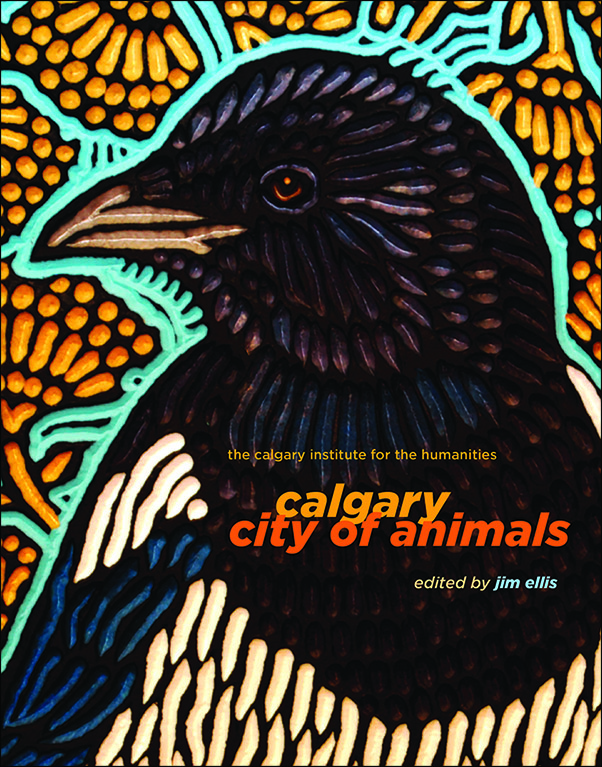
Calgary: City of Animals
Edited by Jim Ellis
$15.99 CAD / $15.99 USD (T)
144 pages, 67 illustrations
7.5 x 9.5 inches
Paperback: 978-1-55238-967-6
Epub: 978-1-55238-970-6
Library PDF: 978-1-55238-969-0
May 2017
Art, design, performance, and scholarship combine to explore the ways that animals and humans have shaped each other in a visually rich, full-colour volume that celebrates Calgary’s rich animal life.
How have our interactions with animals shaped Calgary?
What can we do to ensure that humans and animals in the city continue to co-exist, and even flourish together?
This wide-ranging book explores the ways that animals inhabit our city, our lives and our imaginations.
Essays from animal historians, wildlife specialists, artists and writers address key issues such as human-wildlife interactions, livestock in the city, and animal performers at the Calgary Stampede.
Contributions from some of Calgary’s iconic arts institutions, including One Yellow Rabbit Performance Theatre, Decidedly Jazz Danceworks, and the Glenbow Museum, demonstrate how animals continue to be a source of inspiration and exploration for fashion, art, dance, and theatre.
The full-colour volume is beautifully illustrated throughout with archival images, wildlife photography, documentary and production stills, and original artwork.
With Contributions By: Sean Kheraj, Susan Nance, Shelly M. Alexander, Angela Waldie, Mohammad Sadeghi Esfahlani, Jenna McFarland, Andrea Hunt, Maureen Luchsinger, Laura Griffin, Kimberly Cooper, Paul Hardy, Melanie Kjorlien, the Calgary Wildlife Rehabilitation Society, the Ann & Sandy Cross Conservation Area and the One Yellow Rabbit Ensemble
Jim Ellis is Professor of English at the University of Calgary and Director of the Calgary Institute for the Humanities.
Calgary: City of Animals is published in co-operation with the Calgary Institute for the Humanities.
Preface
Andrew King, Jocelyne Belisle, Lawrence Eisler
Literary Essays
Gregory Elgstrand
Photographic Essays
Lawrence Eisler
Architectural Essays
Andrew King, Jocelyn Belisle, Lawrence Eisler
Building/Art
Jocelyne Belisle
A Reflection on the State of the Theory of Urbanism in North America
Gorge Baird
Urbanisms
Stephanie White
Form/Politic: A Manifesto for a New Public Space
Andrew King
The System: Luminous Veil
Marco Polo
Undisclosed: Architecture in the New Public Landscape
Chris McDonald
Calgary’s Generation
Michael McMoride
Contributor Biographies
A Note on Graphic Design Strategy Lawrence Eisler
Biblography
Acknowledgments
Introduction
Jim Ellis, Director, CIH
How Canadians Used to Use Livestock in Cities
Sean Kheraj
Outlaw Horses and the True Spirit of Calgary In the Automobile Age
Susan Nance
Silence of the Song Dogs
Shelly M. Alexander
Counting Chickadees and Reimagining the Map of Calgary
Angela Waldie
Critical Animal Studies and the Humanities: A Critical Introduction
Mohammad Sadeghi Esfahlani
Wild Animals in the City
Jenna Mcfarland and Andrea Hunt, Calgary Wildlife Rehabilitation Society
Light Pollution in an Animal City
Maureen Luchsinger and Laura Griffin, Ann and Sandy Cross Conservation Area
Excerpt
Our Biodiversity: Calgary’s 10–Year Biodiversity Plan
Squirrel vs. Gopher from Calgary I love You, But You’re Killing Me
One Yellow Rabbit Ensemble
Becoming Insects: A New Universe
Kimberly Cooper, Artistic Director, Decidedly Jazz Danceworks
Kaleidoscopic Animalia: An Exhibition Designed and Curated by Paul Hardy
Paul Hardy and Melanie Kjorlien
Lisa Brawn Interview and Portfolio: Wild Bird Woodcuts
Calgary Institute for the Humanities
Her Dark Materials: Yvonne Mullock’s Dark Horse at Stride gallery
Jim Ellis
Conclusion
Jim Ellis
Notes
Contributors
The usefulness of the work is to place scholarly interventions in conversation with activists working with wildlife rehabilitation and habitat conservation, as well as artists and a museum curator who explore the importance of animals as inspiration and fellow creatures. The book challenges the neat distinctions one might draw among disciplines or among artists, activists, and scholars. It shows not only that animals, human and non-human, might co-flourish in the city, but that those different fields of activity might co-flourish.
—Frederick L. Brown, Network in Canadian History and Environment
A walk through an intriguing city: something striking and new and unexpected seems to be around every corner . . . [it] presents a view of Calgary quite different from its usual self-promoted image.
—Mark Lisac, Prime Times
Outlaw Horses and the True Spirit of Calgary in the the Automobile Age
Critical Animal Studies and the Humanities: A Critical Introduction
Excerpt From "Our Biodivercity", Calgary's 10 Year Biodiversity Strategic Plan
Kaleidoscopic Animalia: An Exhibition Designed and Curated by Paul Hardy
Her Dark Materials: Yvonne Mullock's Dark Horse at Stride Gallery